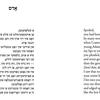3: Poem, Celia Dropkin’s “Adam,” in Yiddish and English translation, 1959.
The Acrobat, published in 2014, is the only dedicated collection of Celia Dropkin’s poetry in English. The translators who put the collection together chose to work with the 1959 version of “Adam,” which combines parts one and two into a single poem, eliminating part three. You can listen to Faith Jones, one of the translators, discuss the translation process on the Yiddish Book Center’s podcast The Shmooze.
Suggested Activity: Invite students to read this translation of the poem and to compare it to the version in resource 1. Track the translators’ choices in each version. Does the different conclusion dramatically change your interpretation of the poem? Is there a subtle difference in meaning and/or style between the translations? If so, in what ways do the translators make clear their interpretations of the poem? Choose a single line to compare across the two translations and perform a close reading of the line, discussing how even a small shift in register or word choice can affect the meaning of an entire poem.
Afterwards, ask students to create their own “translations” in small groups of two or three, drawing from the English translations provided in resources 1 and 3. Which aspects of each translation (such as tone, register, or entire phrases) do they change, and which do they preserve? How do the new translations vary amongst the different groups in the class? Which images do they decide to heighten? Which do they decide to tone down?
Source: Celia Dropkin, “Adam,” The Acrobat: Selected Poems of Celia Dropkin, trans. Faith Jones, Jennifer Kronovet, and Samuel Solomon (Huntington Beach, CA: Tebot Bach, 2014), 38-39.

